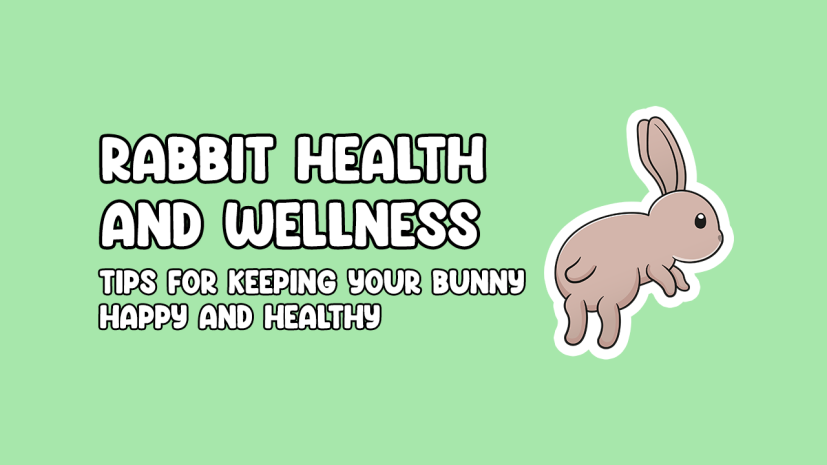
If you’re a rabbit owner, you probably know how adorable and loveable these furry little creatures can be. But, with great pets come great responsibilities.
One of the most important things you need to take care of as a rabbit owner is the health and wellness of your bunny. This article will cover tips and guidelines for keeping your rabbit healthy and happy.

This is Chapter 5 of The Beginner’s Guide to Rabbit Care
One of the most important things you must consider when caring for your rabbit is its diet. Rabbits are herbivores and require a diet high in fiber and low in fat.
You should provide your bunny with fresh hay, pellets, and vegetables daily. Some good vegetables for your rabbit include kale, spinach, carrots, and lettuce.
Rabbits have a unique digestive system that requires a high-fiber diet to function properly. A diet low in fiber can lead to gastrointestinal stasis, a life-threatening condition where the digestive system slows down or stops working altogether.
Additionally, feeding your rabbit a diet high in fat can lead to obesity, which can cause a wide range of health problems.

Proper hydration is crucial for a rabbit’s overall health and well-being. Water is key to many bodily functions, including digestion, circulation, and temperature regulation. A lack of water can lead to dehydration, which can cause serious health problems in rabbits.
You can use a water bottle or a bowl, but change the water daily and clean the container regularly. You may also want to read our breakdown on why bowls are better than water bottles.
Generally, rabbits should drink at least one ounce of water per pound of body weight daily. This means that a 5-pound rabbit should drink at least 5 ounces of water each day.
However, the amount of water a rabbit needs can vary depending on several factors, including their diet, activity level, and environment.
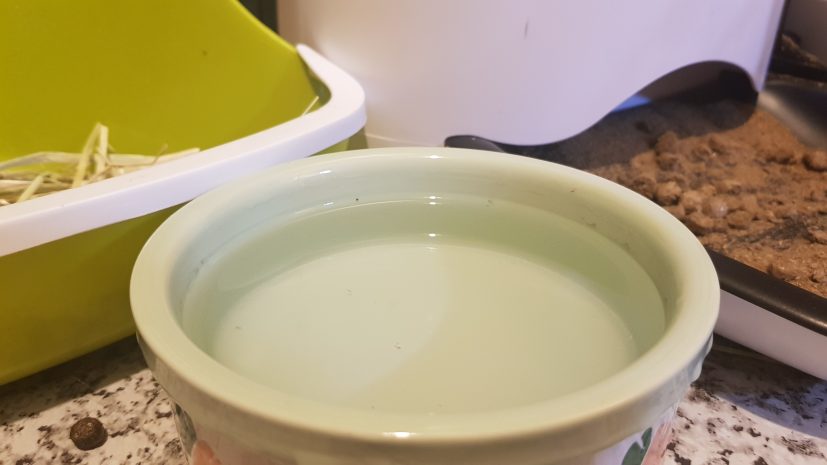
Provide Fresh Water
Fresh water should be available to your rabbit at all times. Ensure that your rabbit has access to clean, fresh water in a water bottle or a heavy ceramic bowl. Change the water daily to prevent bacterial growth.
One way to ensure your rabbit is getting enough water is to add water to their diet. You can do this by soaking your rabbit’s vegetables in water before feeding them or by mixing water with their pellets.
Offer Watery Vegetables
Some vegetables are high in water content and can help keep your rabbit hydrated. Vegetables like cucumber, celery, and romaine lettuce are all great options.
Consider Adding Electrolytes
If your rabbit is not drinking enough water, you may consider adding an electrolyte solution to its water.
Electrolytes can help prevent dehydration and keep your rabbit’s body functioning properly. However, it’s essential to consult a veterinarian before adding supplements to your rabbit’s diet, Do not give your rabbit any supplements unless a veterinarian has given you the go-ahead.
Monitoring your rabbit’s water intake is important to ensure they’re getting enough hydration. Signs of dehydration in rabbits include:
Regular exercise is crucial for a rabbit’s overall health and well-being. Exercise helps keep your bunny’s muscles and joints strong and healthy, prevents obesity and other health problems, and provides mental stimulation and entertainment.
Generally, rabbits should have at least four hours of exercise outside their enclosure each day. This exercise time should include opportunities for running, hopping, and jumping.
However, the amount of exercise a rabbit needs can vary depending on age, weight, breed, and activity level.
The first step to ensuring your rabbit gets enough exercise is to provide them with a large enclosure. A rabbit’s enclosure should be spacious enough for them to move around, stretch out, and stand up on its hind legs without any restrictions.
We recommend that an average breed rabbit’s enclosure or running space be at least 4.5ft x 2.5ft with a 3ft – 5ft height. We always recommend bigger if possible, though!
In addition to providing a large enclosure, it’s essential to let your rabbit out of their enclosure for exercise each day.
If your rabbit is fully free-roam indoors, this doesn’t apply as much, but otherwise, having a dedicated space to run around is great for any living creature’s health.
You can do this by setting up a rabbit-proofed play area in a safe, secure location in your home or by allowing your rabbit to roam free in a rabbit-proofed room.
Providing toys and activities will help your rabbit get enough exercise. It can provide mental stimulation and encourage physical activity, which is important for your rabbit’s overall health and well-being. Here are some of the toys we recommend giving your rabbit access to:
Chew Toys
Rabbits love to chew, and providing them with safe, chewable toys is a great way to keep them entertained and engaged.
Chew toys can help keep your rabbit’s teeth healthy and prevent them from chewing on other objects in your home. Some good options for chew toys include untreated wood blocks, cardboard tubes, and willow balls.
Tunnels and Hideaways
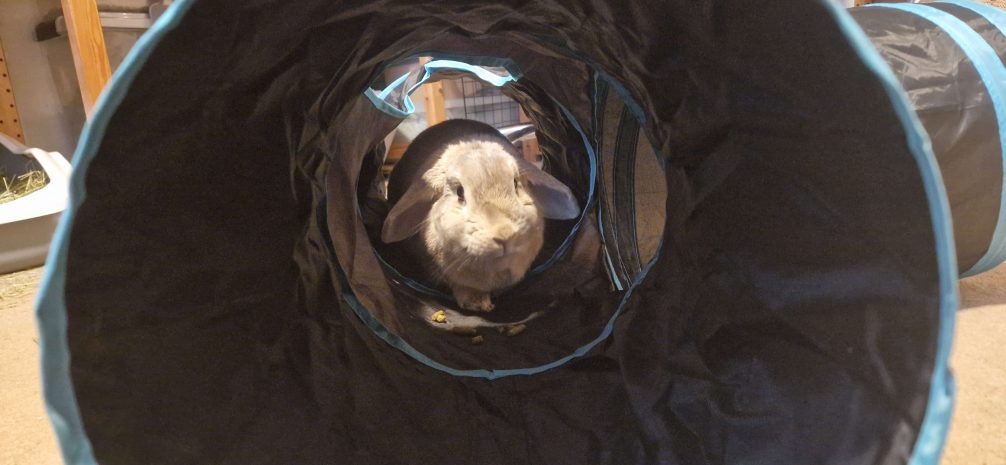
Rabbits love to explore and hide; providing them with tunnels and hideaways can encourage this behavior.
Tunnels made of cardboard or fabric are great options for rabbits, as are small hideaways like igloos or tents. These types of toys provide your rabbit with a sense of security and privacy and can also encourage physical activity.
Puzzle Feeders

Puzzle feeders are toys that require your rabbit to work to get a treat or piece of food. These types of toys provide mental stimulation and encourage problem-solving behavior.
Puzzle feeders can be purchased at pet stores or make your own using items like toilet paper rolls or cardboard boxes.
Balls and Playhouses

Rabbits also enjoy playing with balls and small playhouses. Small balls made of plastic or rubber are great options for rabbits, as are small playhouses made of cardboard or fabric. These toys encourage physical activity and can provide your rabbit with entertainment and mental stimulation.
Digging Boxes
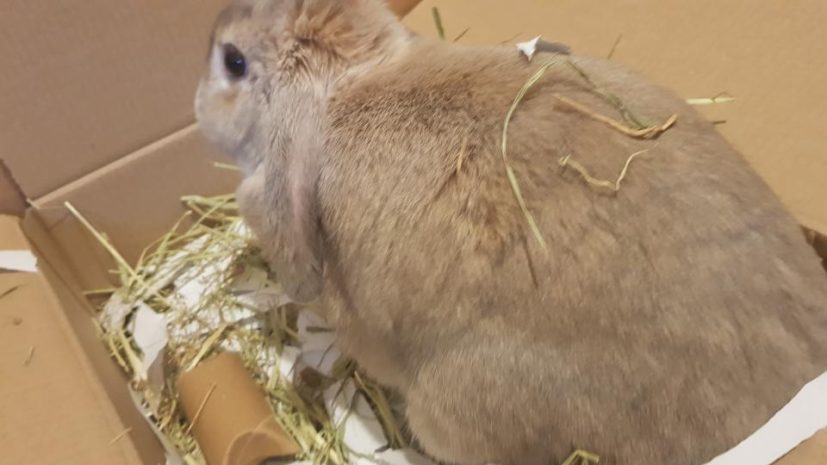
Some rabbits love to dig, and providing them with a digging box can be a great way to encourage this behavior.
A digging box can be as simple as a cardboard box filled with shredded paper or hay. Your rabbit will enjoy digging and burrowing in the box, and it provides a fun and safe outlet for their natural instincts.
Rotating your rabbit’s toys regularly is important to keep them entertained and engaged. Introducing new toys and activities can provide mental stimulation and prevent boredom.
If possible, consider getting a companion rabbit for your bunny. Rabbits are social animals and thrive in the company of other rabbits (Usually in pairs). A companion rabbit can give your bunny a playmate and encourage physical activity.
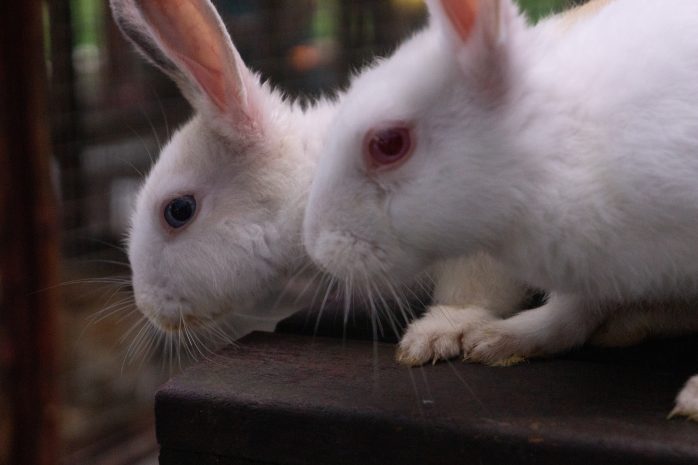
Before getting a second rabbit, there are several factors to consider, including:
Spending time with your rabbit is important for their mental and emotional well-being. Rabbits require at least one to two hours of interactive exercise and playtime outside of their enclosure each day.
In addition, you should spend time interacting with your rabbit, such as petting, playing, and grooming them. The more time you spend with your rabbit, the happier and healthier it will be.
Just because you have only one rabbit doesn’t mean you can spend less time with them than you would with two rabbits. You must actively bond with your bunny as much as possible to build trust, even if it’s just by sitting on the ground with them.
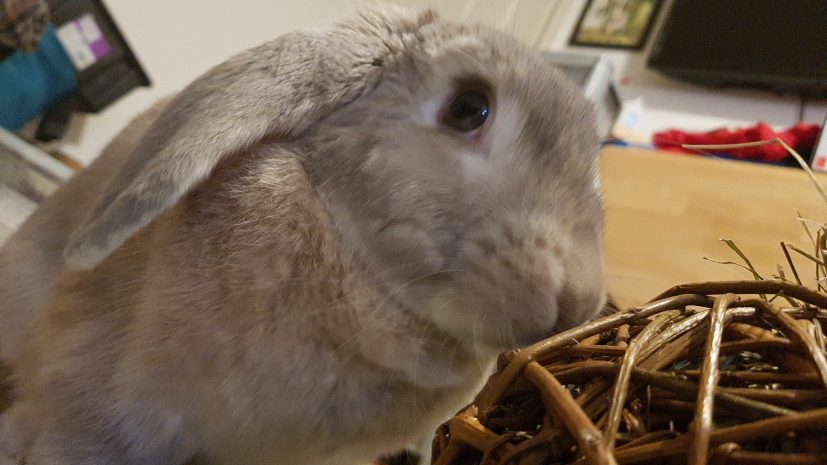
Spaying or neutering your rabbit is important for their health and behavior. Unaltered rabbits can develop health problems, such as uterine cancer in females and testicular cancer in males.
In addition, unaltered rabbits can exhibit aggressive and territorial behavior. Spaying or neutering your rabbit can help prevent these problems and improve their well-being.
Rabbits are social animals and thrive in the company of other rabbits. Having two or more rabbits can provide numerous benefits for your bunnies, including:
While rabbits can live alone, they are social animals and thrive in the company of other rabbits. If you plan on keeping your rabbit alone, you should provide them with plenty of social interaction with humans.
When rabbits are kept alone, they can experience loneliness, boredom, and even depression. These negative emotions can lead to behavioral problems such as aggression, destructive behavior, and decreased appetite.
Rabbits that are kept alone may also become stressed and anxious, which can lead to health problems that include:
Handling your rabbit gently and interacting with them daily can give them the companionship they need and works perfectly fine. At the very least, just sitting at their level is enough to get them begging for attention.
It takes time to bond with your rabbit, some take years, and others take weeks. It’s different for each rabbit, and there’s no solution other than spending time with them and getting them used to your company.
Regular check-ups with a veterinarian are essential to your rabbit’s health. They will ensure that your bunny is up to date on vaccinations and parasite prevention. They can also detect any health issues early on and provide treatment before they become serious.
Rabbits are susceptible to various diseases, some of which can be fatal. Vaccinations can help protect your bunny from these diseases. Regular check-ups also allow the vet to detect any health issues early and treat them before they become serious.
Rabbits can be vaccinated from the age of 5-6 weeks. They require annual booster vaccinations to maintain their immunity.
The Two primary vaccinations are considered essential for rabbits:
Myxomatosis is a viral disease that can cause swelling of the eyes, nose, and genitals, eventually leading to death. RVHD is a highly infectious disease that can cause internal bleeding and liver damage.
Before your bunny’s vaccination appointment, ensure they are healthy and have no underlying health conditions. Talk to your vet about any concerns you may have. You should also check if your bunny is up to date with its flea and worm treatments.
During a vaccination appointment, the vet will perform a complete physical examination of your bunny. They will then administer the vaccine, usually through an injection. After the vaccination, your bunny may experience mild side effects such as lethargy, decreased appetite, or a slight fever.
During your rabbit’s recovery time, you should keep a close eye on them but give them space if needed.
As a bunny parent, ensuring your home is safe for your furry friend is crucial. Rabbits are curious creatures and love to explore their surroundings, which can sometimes lead to accidents. Bunny-proofing your home can help you create a safe and happy environment for your pet.
Bunny proofing is essential to prevent your pet rabbit from accessing dangerous items or areas in your home. Rabbits are natural chewers and can quickly damage furniture, electrical cords, and other household items.
Consuming inappropriate items can lead to digestive problems, dental issues, and even death. Additionally, rabbits can jump high and are excellent escape artists, which can be dangerous if they escape outdoors or access a hazardous area in your home.
Before bunny-proofing your home, you’ll need to gather some essential supplies. Here are some items you may need:
Follow this bunny-proofing checklist to ensure that your home is safe for your pet:
Electrical cords and wires are tempting chew toys for rabbits. Use cord protectors or bitter sprays to discourage your bunny from chewing on them. Additionally, ensure all electrical outlets and power strips are secured with outlet covers.
We recommend using cable protectors, which are also a fantastic way to organize your cables. These can be flexible on secured to the wall.
If you don’t have cable protectors, a tube you can run the cables through should be sufficient.
Many common household items can be toxic to rabbits, including certain plants, cleaning products, and human foods. Store all toxic items in secure cabinets or high shelves inaccessible to your pet.
Here are some common toxic plants for rabbits:
Rabbits are curious and love to explore, but some areas in your home may be dangerous. Block off any hazardous areas, such as balconies, staircases, or areas with sharp objects.
Blocking off hazardous areas is crucial for keeping your pet rabbit safe. Here are some suggestions for blocking off hazardous areas for your bunny:
It’s worth noting that rabbits often destroy your furniture and make it their own. Be aware of this when picking furniture for a room they can access.

Rabbits have a natural instinct to chew, and furniture legs and corners are a favorite target. Protecting your furniture from your bunny’s sharp teeth is essential. Here are some ways to protect your furniture from your rabbit:
Following these tips, you can protect your furniture from rabbit damage and keep your bunny happy and healthy.
Creating a safe space for your rabbit is crucial for their mental and physical well-being. To provide a safe space for your bunny, you can designate a bunny-proofed room or area.
This involves removing all hazardous items and blocking off any dangerous areas. In addition, providing a hideaway for your bunny to retreat to when they feel threatened or stressed is important.
A cardboard box or a wooden house works well for this purpose. This gives your bunny a sense of security and helps them feel comfortable in their safe space.
Giving your bunny enough space to exercise and play is also crucial for their well-being. Consider adding tunnels or obstacles for them to navigate and play with. This can help keep your bunny entertained and engaged.
Lastly, making the space comfortable is important for your bunny’s happiness. A soft blanket or mat for your bunny to rest on can make their safe space cozy and inviting. Additionally, it’s important to ensure that the temperature is comfortable for your bunny.
The ideal temperature for a pet rabbit is between 60-70°F (15-21°C). Rabbits are sensitive to temperature changes and can become stressed or ill if exposed to extreme temperatures.
If the temperature is too hot, your bunny may become overheated and dehydrated; if it’s too cold, it may become hypothermic.
Remember to supervise your bunny at all times and ensure they cannot access hazardous areas, even in their safe space. Providing a safe space can give your rabbit a sense of security and help them live a happy and healthy life.
It’s always a good idea to be prepared for emergencies. Have a first-aid kit and know where the nearest veterinarian is. Know your bunny’s signs of illness and injury, and act quickly if you notice anything unusual.
Being prepared for an emergency is essential to ensure the safety and well-being of your pet rabbit. Here is a checklist for emergency preparedness for your bunny:
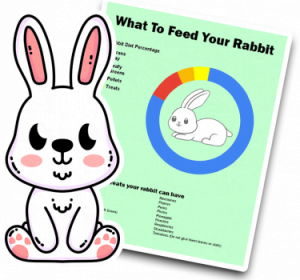
By entering your email address you agree to receive emails from Cottontailclub. We'll respect your privacy and you can unsubscribe at any time.